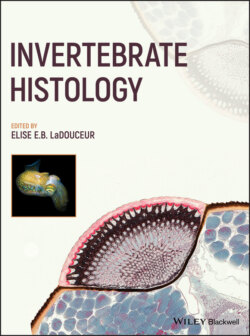Читать книгу Invertebrate Histology - Группа авторов - Страница 26
References
Оглавление1 Ameye, L., Hermann, R., DuBois, P., and Flammang, P. (2000). Ultrastructure of the echinoderm cuticle after fast‐freezing/freeze substitution and conventional chemical fixations. Microscopy Research and Technique 48 (6): 385–393.
2 Bachmann, S. and Goldschmid, A. (1978). Fine structure of the axial complex of Sphaerechinus granularis (lam.) (echinodermata: Echinoidea). Cell and Tissue Research 193: 107–123.
3 Carpenter, R. (1990). Mass mortality of Diadema antillarum. Marine Biology 104: 67–77.
4 Cavey, M. and Märkel, K. (1994). Echinoidea. In: Microscopic Anatomy of Invertebrates, vol. 14 (eds. F. Harrison and F. Chia), 345–400. New York: Wiley.
5 Ferguson, J.C. (1990). Seawater inflow through the madreporite and internal body regions of a starfish (Lepasterias hexactis) as demonstrated with fluorescent microbeads. Journal of Experimental Zoology 255: 262–271.
6 Ferguson, J.C. and Walker, C.W. (1991). Cytology and function of the madreporite systems of the starfish Henricia sanguinolenta and Asterias vulgaris. Journal of Morphology 210 (1): 1–11.
7 Freire, C., Santos, I., and Vidolin, D. (2011). Osmolality and ions of the perivisceral coelomic fluid of the intertidal sea urchin Echinometra lucunter (Echinodermata: Echinoidea) upon salinity and ionic challenges. Zoologia (Curitiba) 28: 479–487.
8 Francis‐Floyd, R., Landsberg, J., Yanong, R., Kiryu, Y., Baker, S., Pouder, D., Sharp, W., Delgado, G., Stacy, N., Waltzek, T., Walden, H. Smolowitz, R., and Beck, G. (2020) Diagnostic methods for the comprehensive health assessment of the long‐spined sea urchin, Diadema antillarum. EDIS 2020 (3). https://doi.org/10.32473/edis‐vm244‐2020
9 Ghyoot, M., de Ridder, C., and Jangoux, M. (1987). Fine structure and presumed functions of the pedicellariae of Echinocardium cordatum (Echinodermata, Echinoida). Zoomorphology 106: 279–288.
10 Ghyoot, M., Dubois, P., and Jangoux, M. (1994). The venom apparatus of the globiferous pedicellariae of the toxopneustid Sphaerechinus granularis (Echinodermata, Echinoida): fine structure and mechanism of venom discharge. Zoomorphology 114: 73–82.
11 Hewson, I., Button, J.B., Gudenkauf, B.M. et al. (2014). Densovirus associated with sea‐star wasting disease and mass mortality. Proceedings of the National Academy of Sciences USA 111 (48): 17278–17283.
12 Holland, N.D. and Nealson, K.H. (1978). The fine structure of the echinoderm cuticle and the subcuticular bacteria of echinoderms. Acta Zoologica 59 (3–4): 169–185.
13 Holland, N.D., Phillips, J., and Giese, A. (1965). An autoradiographic investigation of coelomocyte production in the purple sea urchin (Strongylocentrous purpuratus). Biological Bulletin 128: 259–270.
14 Hyman, L.H. (1955). Class Asteroidea. In: The Invertebrates: Echinodermata, 245–412. New York: McGraw‐Hill, Inc.
15 Kanungo, K. (1984). The coelomocytes of asteroid echinoderms. In: Invertebrate Blood. Comparative Pathobiology, vol. 6 (ed. T. Cheng), 7–39. Boston: Springer.
16 Leake, L.D. (1975). Phylum echinodermata. In: Comparative Histology: An Introduction to the Microscopic Structure of Animals, 321–371. London: Academic Press.
17 Lessios, H. (2016). The great Diadema antillarum die off: 30 years later. Annual Review of Marine Science 8: 1.1–1.17.
18 Märkel, K. and Roser, U. (1983). The spine tissues in the echinoid Eucidaris tribuloides. Zoomorphology 103: 25–41.
19 Märkel, K., Röser, U., and Stauber, M. (1990). The interpyramidal muscle of aristotles lantern: its myoepithelial structure and its growth (Echinodermata, Echinoida). Zoomorphology 109: 251–262.
20 McKenzie, J.D. and Grigolava, I.V. (1996). The echinoderm surface and its role in preventing microfouling. Biofouling 10 (1–3): 261–272.
21 Menge, B.A., Cerny‐Chipman, E.B., Johnson, A. et al. (2016). Sea star wasting disease in the keystone predator Pisaster ochraceus in Oregon : insights into differential population impacts, recovery, predation rate, and temperature effects from long‐term research. PLoS ONE 11 (5): 1–28.
22 Motokawa, T. (1984). Connective tissue catch in echinoderms. Biological Reviews 59 (2): 255–270.
23 Motokawa, T. (2011). Mechanical mutability in connective tissue of starfish body wall. Biological Bulletin 221: 280–289.
24 Mulcrone, R. (2005). Echinodermata. Animal Diversity Web. https://animaldiversity.org/accounts/Echinodermata
25 Nichols, D. (1961). A comparative histological study of the tube‐feet of two regular echinoids. Quarterly Journal of Microscopical Science S3‐102: 157–180.
26 Raup, D.M. (1966). The Endoskeleton. In: Physiology of Echinodermata, 379–395. New York: Wiley.
27 Ruppert, E.E., Fox, R.S., and Barnes, R.D. (2004). Echinodermata. In: Invertebrate Zoology, 7e, 872–929. Brooks/Cole: Belmont.
28 Walker, C., Unuma, T., and Lesser, M. (2007). Gametogenesis and reproduction of sea urchins. In: Developments in Aquaculture and Fisheries Science (ed. J. Lawrence), 11–33. St Louis: Elsevier.
29 Wilkie, I. (2002). Is muscle involved in the mechanical adaptability of echinoderm mutable collagenous tissue? Journal of Experimental Biology 205: 159–165.
30 Work, T.M. (n.d.) Histology manual for Tripneustes gratilla. US Geological Survey, National Wildlife Health Center, Hononlulu Field Station. 9pp.
31 Xing, K., Yang, H., and Chen, M. (2008). Morphological and ultrastructural characterization of coelomocytes in Apostichopus japonicus. Aquatic Biology 2: 85–92.
32 Ziegler, A., Faber, C., and Bartolomaeus, T. (2009). Comparative morphology of the axial complex and interdependence of internal organ systems in sea urchins (Echinodermata: Echinoidea). Frontiers in Zoology 6: 10–10.
33 Ziegler, A., Schroder, L., Ogurreck, M. et al. (2012). Evolution of a novel muscle design in sea urchins (Echinodermata: Echinoidea). PLoS One 7: e37520.
